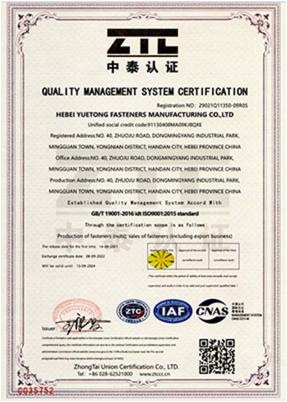Nov . 08, 2024 03:05 Back to list
Choosing the Right Wall Plugs and Bolts for 10mm Installations in Your Projects
Understanding 10mm Wall Plugs and Bolts A Comprehensive Guide
When it comes to home improvement and construction, the right materials can make all the difference. Among these materials, 10mm wall plugs and bolts are essential components that play a pivotal role in ensuring the durability and safety of various installations. This article aims to delve into the specifics of 10mm wall plugs and bolts, their uses, types, and how to properly utilize them for optimal results.
What are Wall Plugs?
Wall plugs, also known as anchors or dowels, are mechanical devices used to attach items to walls, especially when the wall material is not strong enough to hold screws directly. The primary function of a wall plug is to provide a secure hold for screws, allowing for the mounting of shelves, pictures, and heavy objects without the risk of falling or damaging the wall.
10mm wall plugs are designed specifically for use with 10mm screws or bolts. The size indicates the diameter of the screw that can fit into the plug, making it crucial to match the plug size with the corresponding screw for effective use.
Types of Wall Plugs
There are several types of wall plugs available in the market, each suited to different wall materials
1. Plastic Wall Plugs These are the most common type and are suitable for lightweight applications in drywall or masonry. They expand when a screw is inserted, creating a tight grip.
2. Metal Wall Plugs Designed for heavier loads, metal plugs are often used in solid walls. They provide superior strength and are less likely to pull out compared to their plastic counterparts.
3. Toggle Bolts These are ideal for hollow walls (like drywall) where other types of plugs may not provide sufficient support. Toggle bolts feature a wing mechanism that opens up behind the wall, distributing the weight across a larger area.
10mm wall plugs and bolts

Choosing the Right Wall Plug and Bolt
When selecting a 10mm wall plug and bolt combo, it’s vital to consider both the weight of the item being mounted and the type of wall material. Heavy shelving units or televisions require stronger anchors and bolts.
For example, if you are hanging a multiple-shelf unit on a concrete wall, you would opt for metal wall plugs or sleeve anchors. For lighter items on drywall, standard plastic wall plugs may suffice. Always ensure that the load-bearing capacity of the wall plug matches or exceeds the weight of the object being mounted.
Installation Process
Installing a 10mm wall plug and bolt is a straightforward process, but proper technique is critical for safety
1. Drill the Hole Using a drill bit that matches the diameter of the plug, create a hole in the wall at the desired location. The hole should be slightly deeper than the length of the plug.
2. Insert the Wall Plug Push the wall plug into the hole until it is flush with the wall surface. If necessary, gently tap it with a hammer to ensure it is fully seated.
3. Insert the Screw or Bolt Align the item you are mounting over the plug, insert the screw through it, and tighten. For bolts, ensure you use a washer and nut if needed to secure the item properly.
4. Check for Stability Once installed, give a gentle tug on the mounted item to ensure that it is securely attached.
Conclusion
In summary, 10mm wall plugs and bolts are vital components for anyone looking to securely mount items in their home or workspace. Understanding the types of wall plugs, selecting the right one based on wall material, and following proper installation techniques can lead to successful and safe installations. Whether you are a DIY enthusiast or a professional contractor, mastering the use of wall plugs and bolts will undoubtedly enhance your craftsmanship and the quality of your work.


